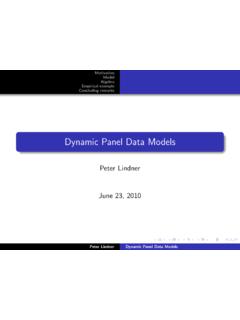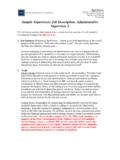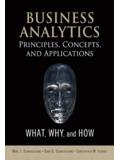Transcription of EVALUATING FORECAST ACCURACY - univie.ac.at
1 406347 UK konometrische Prognose SS 2004. University of Vienna Department of Economics EVALUATING FORECAST ACCURACY . 0001078 Elisabeth Woschnagg 9501689 Jana Cipan CONTENT. 1 INTRODUCTION .. 2. MODEL-BUILDING PROCEDURE USING THE SAME DATA SET ..2. 2 MODEL UNCERTAINTY .. 3. DATA DRIVEN INFERENCE ..4. SOME RESEARCH FINDINGS ..4. Inferential biases narrow prediction intervals ..4. WAYS OF GETTING MORE REALISTIC ESTIMATES OF PREDICTION ERROR ..5. Bayesian model averaging ..6. 3 COMPARING OUTCOME AND 7. MINIMUM Allowing for parameter MSFEs for scalar multi-step TESTING FOR UNBIASEDNESS.
2 10. DATA SPLITTING ..11. RIVAL FORECASTS ..12. 4 RELEVANT MEASURES IN FORECAST EVALUATION .. 12. STAND-ALONE ACCURACY MEASURES ..13. RMSE ..13. Decomposition of the MAE ..14. RELATIVE MEASURES ..15. The standardized root mean-squared STABILITY TO LINEAR TRANSFORMATION ..16. REFERENCES .. 17. 1. 1 Introduction The history of the evaluation of FORECAST ACCURACY goes along with that of time-series analysis. The first tests for forecasting models were developed in 1939 by Tinbergen, in response to Keynes, who stated that theories must be confirmed if the data and statistical methods are employed correctly.
3 A crucial criticism is the Lucas Critique. It states that the future development is influenced by forecasts, because expectations are self-fulfilling. This produces a circuit and raises the questions how forecasts should take into account the fact of self-fulfilling prophecies in time- series forecasting . This theory implies that forecasts are informational input for the data generating process (DGP), and that they are invalidated by agents reacting to them. Therefore, forecasts are susceptible to biasedness. Opponents of the Lucas critique claim that forecasts are no probability-based techniques that point into the future, but rather extrapolative patterns.
4 In any statistical problem, the three main sources of uncertainty are: Uncertainty about the estimates of the model parameters, assuming that the structure of the model is known Uncertainty about the data, for example unexplained random variations of the observed variable or measurement errors. Model uncertainty: Uncertainty about the structure of the model, for example because the model is misspecified a priori or because the assumption that the model parameters are fixed is wrong. Standard analysis ignores model uncertainty. Model-building procedure using the same data set The Box-Jenkins model-building procedure suggests the following proceeding for econometric data analysis.
5 Model specification means formulating a sensible time-series model that is a plausible approximation and predicts future data with adequate precision. 2. After assuming a sensible time-series model to be correct, the model is fitted. Parameters which are unobservable are estimated, and strategies are used such as excluding, down- weighting and adjusting outliers or transformations to achieve normality or constant residual variance. Biases in the model-fitting process carry on to predictions. For example, parameters may be biased using the same set of data for estimation and for model selection.
6 The third step is to check for the model's rationality also referred to as calibration. The shorter the interval is for which the prediction is made, the more input variables for model selection and fitting one gets. Still, uncertainty may be reflected better by choosing wider intervals for prediction. An issue that is criticized with emphasis by Chatfield is that problems arise from formulating, fitting and testing a model using the same set of data. The least squares theory does so. Biases arrising from this procedure are called model-selection biases. 2 Model uncertainty The standard time series literature assumes that there is a true model for a given time series and that this model is known before it is fitted to the data.
7 After fitting the true' model to the data the same model is then used for forecasting . Regarding econometric models, the model may be misspecified a priori or the parameters assumed to be fixed when they change through time. In addition, in time series forecasting the uncertainty problem arises because the model is defined, fitted and tested using the same set of data. Chatfield (2000) departs from the assumption that a true model does not exist. The main task would then be to find a model that provides an adequate approximation to the given data. One model, that seems to fit the underlying data best, may be selected as a winner' although the other models give a fit very close to the one selected.
8 The properties of an estimator may depend, not only on the selected model, but also on the selection process. 3. Data driven inference Data dredging is the general process of selecting a model from a large set of candidate models, and then used for inference and forecasting1. An example for data-dredging is the search for calendar effects in stock market behavior. Analysts may be able to discover some regularity when looking at financial series over different time periods. But this regularity may fail to generalize to other time periods or to other similar variables.
9 The analyst tests this effect because it has been spotted in the data and it may prove significant. This type of data- driven inference is likely to produce spurious results and suspect forecasts. Based on such results rules for investing in the stock market may be recommended, such as Sell on the first day of the month' or Buy on Friday'. Testing for the presence of unit roots, autocorrelated residuals, presence of break points, indicates model uncertainty. The more models are seen as potential candidates of a true model and the more testing is carried out on the same data used to fit the model, the more inference will be biased.
10 In EVALUATING the forecasts the question arises how this uncertainty about the model will affect the estimates of the FORECAST ACCURACY . Some research findings If a time-series model is selected by minimizing the within-sample prediction mean square error (PMSE) then the Optimism Principle applies. The fitting of a model gives optimistic results in that the performance on new data is on average worse than on the original data. In particular, the fit of the best-fitting model is typically better than the resulting ACCURACY of out- of-sample forecasts. Inferential biases narrow prediction intervals Empirical studies have shown that the prediction intervals are too narrow in that 95% - prediction intervals will contain less than 95% of actual future observations.
















